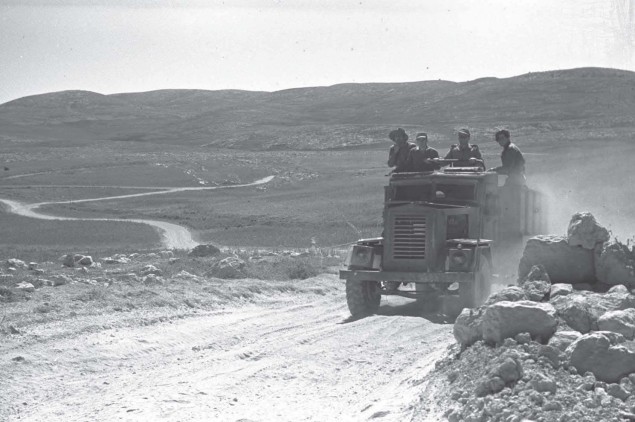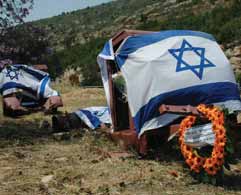On and Off the Beaten Track in…the Har’el Lookout
 During Israel’s War of Independence, the construction of the Burma Road, a bypass to Jerusalem through the mountains, was an extraordinary feat that allowed Jewish soldiers to avoid the dangers of the main road.
During Israel’s War of Independence, the construction of the Burma Road, a bypass to Jerusalem through the mountains, was an extraordinary feat that allowed Jewish soldiers to avoid the dangers of the main road.
Photo: Israel Government Press Office
As I write these lines, Israel is continuing to battle for its very existence, fighting the Hamas terrorists who persist in targeting our schools, our homes and our very lives. During times such as these, it’s often helpful to reflect on earlier stages in the Arab-Israeli conflict, to gain insight and perspective from our previous successes and—unfortunately—from our failures. A visit to the Har’el Lookout provides one with the perfect opportunity to do so.
Israel’s War of Independence did not start, as is commonly thought, on May 15, 1948 (Hey Iyar), with the Declaration of Independence. According to most historians, it actually began on November 30, 1947—the day after the historic Partition Plan was approved by the General Assembly of the United Nations (UN). The plan called for the splitting of Palestine into a Jewish state and an Arab state, and effectively terminated the British Mandate. Tragically, as the Yishuv in Eretz Yisrael began to prepare for statehood, the Arabs began to prepare for war. Any sense of optimism that the Arab world would work in accordance with the UN resolution was shattered with the first attacks on Jewish communities all over Palestine in early December.
In order to prevent the implementation of the Partition Plan, the Arabs embarked on a strategy of besieging isolated settlements and communities and attacking civilian traffic. Jerusalem was cut off from other major Jewish population centers located primarily along the Mediterranean coast between Tel Aviv and Haifa. Perched on the Judean Hills, Jerusalem can be accessed by only four main roads—one from the east (the Jericho Road), one from the south (from the direction of Hebron), one from the north (the direction of Ramallah and Shechem) and the main road from the west (from Tel Aviv and the coastal plane). It was this last road that the Arabs blockaded. Any vehicle attempting to reach Jerusalem was subject to ambush and attack from the Arab villages situated along the Tel Aviv-Jerusalem corridor.
Tragically, as the Yishuv in Eretz Yisrael began to prepare for statehood, the Arabs began to prepare for war.
The most vulnerable section of the road was a very narrow, steep and winding stretch through a pass in the foothills of the Judean Hills, where the road climbs from the coastal plane on its way towards Jerusalem at an elevation of 2,500 feet. This portion of the road, known as “Sha’ar Hagay” (“Bab El Wad” in Arabic), was the most dangerous to traverse. Arabs frequently ambushed Jewish vehicles along this section of the road, the last twenty kilometers (about twelve miles) before Jerusalem. Convoys of trucks that brought vital food, medicine and water to the besieged city were frequently turned back by the attacks, and many drivers were killed. The Haganah responded to these attacks by placing armor plating around the trucks to protect the drivers. As a result, the vehicles, already laden with supplies, became heavier and slower than before and were even more vulnerable to Arab attacks. Between January 1948 and the successful conquest of the road in July of that year, there were many casualties. Often, weeks at a time passed without provisions reaching the 100,000 Jerusalemites who lived under siege, forcing rationing of the ever-dwindling food supplies. Finally, Jewish forces determined that it was necessary to construct a bypass road through the seemingly impassable mountains around Jerusalem. They accomplished this by building the makeshift Burma Road; originally a goat trail, it was neither paved nor easily passable. Construction of the road was therefore an extraordinary feat, and it ultimately enabled Jewish soldiers to avoid the main road, saving Jerusalemites from starvation.
In June 1948, the Har’el Brigade of the Palmach ultimately succeeded in securing the Sha’ar Hagay section of the road and putting an end to the Arab siege. Unfortunately, despite three desperate attacks, the Haganah was unable to secure the British-abandoned police station at Latrun, which was occupied by the Jordanian Legion. Thus, this vital crossroads remained in Jordanian hands until the Six-Day War in 1967.
 Skeletons of armor-plated vehicles that were part of the convoys providing supplies to a blocked-off Jerusalem are scattered along the Sha’ar Hagay section of the road from Tel Aviv to Jerusalem.
Skeletons of armor-plated vehicles that were part of the convoys providing supplies to a blocked-off Jerusalem are scattered along the Sha’ar Hagay section of the road from Tel Aviv to Jerusalem.
Photo: Yehoshua Halevi
Today, sixty-one years later, we are reminded of the convoys that kept Jerusalem alive during this critical period, when the future of Jerusalem and of a Jewish state hung in the balance. The road through Sha’ar Hagay, which is now the main road from Tel Aviv (and Ben-Gurion Airport) to Jerusalem, is no longer narrow but a modern four-lane highway. Many of the curves have been eliminated and thousands of vehicles pass through this corridor daily. But at a number of locations along the road, some of the skeletons of armor-plated vehicles have been assembled as a reminder of the sacrifice and determination that were necessary to maintain a flow of food and medicine to Jerusalem during the siege in 1948.
The full story of the armor-plated convoys (“shayarot” in Hebrew) is also told dramatically, by means of a large relief map and descriptive panels, at a place called the Har’el Lookout. A serene, forested spot on the Beit Shemesh-Ramla thoroughfare, the Har’el Lookout offers a view of the Burma Road. You can access this site, which overlooks the Latrun-Sha’ar Hagay area, from Route #44, which is parallel to the main road and connects the Shimshon Junction (near Beit Shemesh) with the Nachshon Junction to the west, a few kilometers south of Latrun. This road was actually the main road to Jerusalem between 1948 and 1967, the period during which the Latrun area was still under the control of the Jordanian Legion and before the modern road was built. Look for the brown sign to the Har’el Lookout on the north side of the road (on your right, if you are traveling from the Shimshon Junction to the Nachshon Junction). Take the exit, and drive about two kilometers (1.2 miles) to the lookout. The site is free and is a great photo spot. But more importantly, a visit to the lookout reminds us of the challenges and obstacles we faced, and the sacrifices we made, in creating a Jewish state only sixty-one years ago.
Mr. Abelow is a licensed tour guide and the associate director of Keshet: The Center for Educational Tourism in Israel. Keshet specializes in creating and running inspiring family and group tours that make Israel come alive “Jewishly.” He can be reached at 011.972.2.671.3518 or at peter@keshetisrael.co.il.
